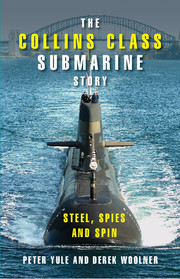Book contents
- Frontmatter
- Contents
- List of key people
- List of acronyms
- Introduction
- Part 1 You Can't Build Submarines in Australia
- 1 ‘The one class of vessel that it is impossible to build in Australia’: Australia's early submarines
- 2 Australia's Oberon class submarines
- 3 The submarine weapons update program and the origins of the new submarine project
- 4 The new submarine project
- 5 ‘We can't build submarines, go away’: Eglo Engineering and the submarine project
- 6 The acts of the apostles
- 7 ‘But how will you judge them?’: the tender evaluation process 1984–85
- 8 Spies, leaks and sackings: from tender evaluation to project definition study
- 9 The project definition study 1985–86
- 10 Debating the laws of physics: picking winners 1987
- Part 2 The Honeymoon Years 1987–92
- Part 3 ‘A Strange Sense of Unease” 1993–98
- Part 4 Resolution
- Notes
- Index
2 - Australia's Oberon class submarines
Published online by Cambridge University Press: 05 September 2013
- Frontmatter
- Contents
- List of key people
- List of acronyms
- Introduction
- Part 1 You Can't Build Submarines in Australia
- 1 ‘The one class of vessel that it is impossible to build in Australia’: Australia's early submarines
- 2 Australia's Oberon class submarines
- 3 The submarine weapons update program and the origins of the new submarine project
- 4 The new submarine project
- 5 ‘We can't build submarines, go away’: Eglo Engineering and the submarine project
- 6 The acts of the apostles
- 7 ‘But how will you judge them?’: the tender evaluation process 1984–85
- 8 Spies, leaks and sackings: from tender evaluation to project definition study
- 9 The project definition study 1985–86
- 10 Debating the laws of physics: picking winners 1987
- Part 2 The Honeymoon Years 1987–92
- Part 3 ‘A Strange Sense of Unease” 1993–98
- Part 4 Resolution
- Notes
- Index
Summary
Although Allied submarines based in Fremantle and Brisbane wreaked havoc on Japanese shipping during the Second World War, Australian naval authorities showed no interest in acquiring submarines afterwards. Yet submarines were needed for antisubmarine warfare training and in 1949 it was arranged that the Royal Navy's fourth submarine flotilla (normally consisting of two or three submarines) would be based in Sydney. This forced Cockatoo Island Dockyard to develop expertise for maintaining and refitting submarines – complex tasks requiring advanced technical skills lacking in Australia during its brief periods of submarine ownership. Until 1960 the British submarines were refitted in Singapore but between 1961 and 1966 five refits were successfully carried out at Cockatoo Island.
In the late 1950s Australia again began to debate the ownership of a submarine force, led by John Gorton, whose term as Minister for the Navy was noted for his questioning of many of the navy's dogmas. In 1959 the Chiefs of Staff considered the issue and decided that ‘the institution of a submarine service would be a valuable addition to balanced Australian Defence Forces’. Their report argued that the main role of Australian submarines would be to train anti-submarine forces and, in wartime, to ‘hunt and kill’ enemy submarines. By now they had recognised that Australian anti-submarine training could not rely indefinitely on Britain maintaining its squadron in Sydney. They saw little potential for the use of submarines for offensive action.
- Type
- Chapter
- Information
- The Collins Class Submarine StorySteel, Spies and Spin, pp. 11 - 19Publisher: Cambridge University PressPrint publication year: 2008



